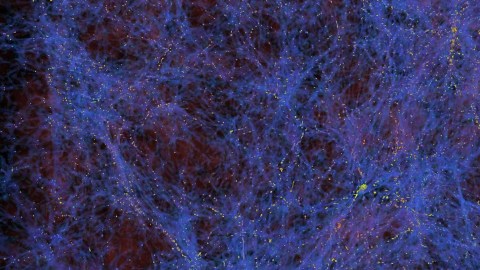Scientists discover how to trap mysterious dark matter

- Scientists working on the Large Hadron Collider (LHC) devised a method for trapping dark matter particles.
- Dark matter is estimated to take up 26.8% of all matter in the Universe.
- The researchers will be able to try their approach in 2021, when the LHC goes back online.
After finding one mysterious particle – the Higgs Boson – scientists working with the Large Hadron Collider are looking to discover another needle in a haystack – dark matter.
It is supposed to be quite well dispersed around us – in fact, dark matter is estimated to take up about 26.8% of all the content of the universe. The other 68.3% is gobbled up by dark energy, a no less-mysterious conjecture. Both are essentially keeping our Universe bound together. Normal matter, if you are wondering, takes up about 4.9% of everything. Not all that much for the part that includes us.
One big problem with dark matter – no one has seen it. We just know of it from its effects like seeing how gravity affects it. How to finally spot dark matter directly is what scientists from the University of Chicago were looking to figure out in their new paper. They came up with a novel method for trapping dark matter in the Large Hadron Collider by taking advantage of the dark particle’s lower speed.
The study was conducted by Lian-Tao Wang, a University of Chicago professor of physics, UChicago postdoctoral fellow Jia Liu and Fermilab scientist Zhen Liu (now at the University of Maryland).
“We know for sure there’s a dark world, and there’s more energy in it than there is in ours,” said Lian-Tao Wang.
The theorists propose that one kind of dark particle is heavier and slower and some times interacts with normal matter. It also has a somewhat longer lifetime of up to one tenth of a second. The scientists believe that there are occasions in each decade when such particles can be found within the proton collisions engineered at the LHC.
In a press release, Wang explained that these special dark particles could be “coupled to the Higgs boson in some fashion”. This would make the Higgs boson, “a portal to the dark world,” said Wang.
One possibility is that the Higgs actually turns into these longer-living dark particles as it decays.
What Is Dark Matter? Michio Kaku explains.
The answer to this question is at the cutting edge of science, …
But how to trap the dark particle among the billions of collisions happening at the LHC every second? Liu, the first author of the study, thinks that such a dark particle would be heavier and thus travel slower than the speed of light. That would keep it separated from the others. The method devised by the scientists would zero in on such particles that decay at a lower rate.
The difference could be as small as a nanosecond or even smaller. But the sensors of the LHC, already an amazing machine, would be able to detect such anomalies.
Liu believes the LHC has the capability to try their idea out and find the particles. One problem, however – their team will have to wait.
Most famous for the discovery of the Higgs Boson particle, the Large Hadron Collider (LHC), the world’s largest scientific instrument, is currently offline. It is undergoing improvements that will give it a power boost. When it goes back up online in 2021, the LHC’s energy output will be a trillion electron volts higher, at 14 trillion volts.
The road to High Luminosity: what’s next for the LHC?
Will the extra power, the Swiss-based 27-km collider operated by CERN, can help us find dark matter, argues Liu. “We think it has great potential for discovery,” he said, adding, “If the particle is there, we just have to find a way to dig it out. Usually, the key is finding the question to ask.”
You can read the new paper in Physical Review Letters.





